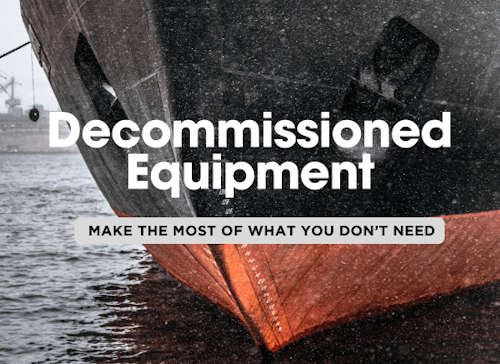Decommissioned Equipment: 10 Smart Ways to Make the Most of What You Don’t Need

As ships age, the equipment onboard often reaches the end of its useful life before the vessel itself does. Whether it's outdated technology, parts from upgrades, or machinery that just doesn’t meet new standards, decommissioned equipment piles up quickly. But just because these items are no longer essential doesn’t mean they’re worthless! Shipowners have plenty of options to make the most of their decommissioned equipment, from resale and recycling to creative upcycling. Here’s your guide to turning unused gear into savings, sustainability, or even extra cash. 🌍⚙️

1. Resale – 🛒 Turn Decommissioned Equipment into Revenue
Reselling equipment can be a straightforward way to gain value from items no longer in use. Many ship parts, especially if they’re in good condition, still hold market value. This option is especially viable if you’re upgrading your equipment but your older model is still functional and in demand.
- Where to Sell: Look for marine equipment brokers, specialized auction sites, or online marketplaces that cater to maritime industry buyers.
- Benefits: Resale can bring in a decent return, help recover some of the initial cost, and avoid waste.
- Considerations: Ensure all items are in good working condition, and provide detailed specifications to attract potential buyers.
Tips
- Best for: Equipment that is functional and has demand in the secondary market
- Potential Revenue: 💰 Moderate to High
- Environmental Impact: ♻️ Positive (reduces waste and supports reuse)
2. Recycling – ♻️ Dispose Responsibly and Earn Sustainability Points
For items that are too old or broken to resell, recycling is the next best option. Shipowners can recycle various materials like metals, plastics, and electronic components, which reduces landfill waste and helps conserve resources.
- How to Recycle: Partner with specialized recycling facilities that handle industrial-grade materials and are equipped for large maritime components.
- Benefits: Recycling responsibly removes clutter, reduces environmental impact, and ensures that hazardous items are processed safely.
- Considerations: Some materials, such as batteries or electronics, may need specific disposal processes, so partnering with a certified recycler is crucial.
Tips
- Best for: Equipment that’s no longer functional or lacks resale value
- Cost Savings: 💲 Minimal (some facilities offer free recycling, while others may charge a fee)
- Environmental Impact: 🌱 High (promotes eco-friendly practices and resource conservation)
3. Donation – 🎁 Give Back and Support the Maritime Community
When decommissioned equipment is still in decent condition but may not bring in much through resale, donating it can be a meaningful option. Maritime schools, training centers, or non-profit organizations can often benefit from equipment for hands-on learning or operational support.
- Who to Contact: Reach out to maritime academies, vocational schools, or non-profits that support maritime education or community initiatives.
- Benefits: Donations help provide resources for maritime education, reduce waste, and may offer tax benefits in some regions.
- Considerations: Ensure the equipment is safe, functional, and meets the needs of the organization you’re donating to.
Tips
- Best for: Equipment that’s functional but lacks high resale value
- Financial Impact: 💵 Minimal to Moderate (possible tax benefits)
- Community Impact: 🤝 High (supports education and community development)
4. Repurposing – 🔧 Find New Uses for Old Equipment Onboard
If you’re not ready to let go of an item, consider repurposing it for alternative uses onboard. Old machinery or parts can sometimes be creatively adapted to serve a different function, from spare parts storage to creating functional items for non-critical applications.
- How to Repurpose: Identify which components are suitable for other uses or can be adapted to fit minor tasks that don’t require new equipment.
- Benefits: Repurposing saves money on new purchases and extends the life of equipment, promoting sustainable resource use.
- Considerations: Be sure that repurposing doesn’t compromise safety or operational efficiency. Consulting with an engineer can help with safe adaptation.
Tips
- Best for: Equipment with potential for non-critical applications
- Cost Savings: 💸 High (avoids the cost of buying new items)
- Sustainability Impact: 🌍 Positive (reduces the need for new materials and waste)
5. Spare Parts – ⚙️ Stockpile for Future Repairs and Maintenance
Sometimes, it’s worth holding onto decommissioned equipment for its spare parts. When stored properly, functional components can be repurposed during future repairs or maintenance, reducing downtime and cutting costs on new parts.
- How to Use as Spares: Identify and catalog the usable components from decommissioned items, such as valves, seals, or electronic parts, and store them in a safe, organized area.
- Benefits: Having spare parts on hand can reduce emergency repair costs and keep operations running smoothly.
- Considerations: Make sure to store parts in appropriate conditions to maintain functionality and minimize wear or degradation over time.
Tips
- Best for: Items with components that wear out frequently or are costly to replace
- Cost Savings: 💲 High (saves on emergency purchases and shipping)
- Operational Impact: 🛠️ High (quick access to parts in emergencies)
6. Auctioning – 🏷️ Find Buyers Through Specialized Auction Platforms
For equipment with niche value, maritime auction platforms can help reach the right buyers. Auctions are often ideal for decommissioned items that may not have immediate buyers in your network but could interest a broader or international audience.
- How to Auction: List the items on specialized maritime auction sites or consult with auction brokers experienced in the marine industry.
- Benefits: Auctions can draw competitive bids, helping you potentially get a higher price than typical resale.
- Considerations: Factor in any fees associated with auctioning and ensure you meet any listing requirements specific to each platform.
Tips
- Best for: Items with niche value or limited local demand
- Potential Revenue: 💵 Moderate to High (depends on buyer interest)
- Reach: 🌎 Global (connects with buyers outside local markets)
7. Trade-In Programs – 🔄 Upgrade While Reducing Costs
For shipowners looking to replace older equipment with newer models, trade-in programs can be a win-win. Many marine suppliers offer trade-ins where you return your decommissioned equipment in exchange for a discount on new purchases.
- How to Trade In: Contact your equipment suppliers to inquire about trade-in options or promotions for upgrading to newer models.
- Benefits: Trade-ins reduce the upfront cost of new purchases and simplify the process of offloading old equipment.
- Considerations: Not all equipment qualifies for trade-ins, and discounts vary based on the condition and demand for your decommissioned items.
Tips
- Best for: Items that are still functional but due for an upgrade
- Cost Savings: 💲 Moderate to High (reduces the cost of new equipment)
- Convenience Impact: 🛍️ High (streamlined process through supplier programs)
8. Leasing or Renting Out – 📅 Generate Income from Usable Equipment
If your decommissioned equipment is still in good working order, leasing or renting it out can be an excellent way to generate ongoing revenue. Other shipowners, especially those with temporary needs, may be interested in renting equipment for specific projects or short-term use.
- How to Lease or Rent: List the equipment on maritime rental platforms or connect with local shipowners to establish rental agreements.
- Benefits: Leasing creates a passive income stream and allows others to benefit from equipment that would otherwise go unused.
- Considerations: Make sure to establish clear rental terms, maintenance responsibilities, and return conditions to protect your equipment’s value.
Tips
- Best for: Functional equipment that doesn’t need to be kept on hand
- Revenue Potential: 💰 High (passive income potential)
- Flexibility Impact: 🔄 High (equipment remains available for future needs if ownership is retained)
9. Storage for Future Needs – 📦 Prepare for Unforeseen Demands
Storing decommissioned equipment may be beneficial for items that don’t currently have a use but could come in handy later. Proper storage keeps these items ready for future repairs, repurposing, or even emergency replacements, reducing the need for urgent purchases down the line.
- How to Store: Set up a designated storage area with proper climate control to prevent rust, corrosion, or degradation of sensitive components.
- Benefits: Ready access to equipment can minimize downtime and costs during unexpected equipment failures.
- Considerations: Ensure the equipment is stored in conditions that prevent deterioration and regularly inspect stored items to maintain readiness.
Tips
- Best for: Equipment with potential future use or in remote locations
- Cost Savings: 💲 Moderate (avoids emergency purchases)
- Emergency Preparedness: 🚨 High (items available when needed)
10. Upcycling Projects – 🎨 Transform Equipment into Useful or Decorative Items
For shipowners interested in sustainable practices and creativity, upcycling old equipment can be both practical and enjoyable. From turning old parts into functional tools to creating unique decor for the ship or office, upcycling decommissioned items breathes new life into what would otherwise be waste.
- How to Upcycle: Identify pieces that could serve as functional items or be modified for aesthetic appeal. Popular ideas include repurposing gears into clocks, turning metal parts into decorative pieces, or using wooden items for furniture.
- Benefits: Upcycling supports sustainable practices and can enhance morale with custom, unique decor.
- Considerations: Some upcycling projects may require craftsmanship or tools, so choose projects that fit your crew’s skills and available resources.
Tips
- Best for: Durable items or those with a distinct look
- Cost Savings: 💲 Low to Moderate (lowers disposal costs and creates useful items)
- Sustainability Impact: 🌱 High (promotes eco-friendly, zero-waste practices)
Table Summary
| ShipUniverse: Decommissioned Equipment Solutions | ||||
| # | Solution | Description | Best For | Impact |
| 1 | Resale | Sell items in good condition. Perfect for equipment still in demand. Use marine brokers, auction sites, or marketplaces to reach buyers and get decent returns. | Functional equipment with market demand | 💰 Revenue, ♻️ Reduces waste |
| 2 | Recycling | Recycle items too old or broken to resell. Use certified facilities to handle industrial-grade materials, minimizing waste and environmental impact. | Non-functional equipment with limited resale value | 🌱 Eco-friendly, ✅ Safe disposal |
| 3 | Donation | Donate working equipment to maritime schools or non-profits. Great for items without high resale value but still functional. Supports education and the community. | Functional items with limited resale demand | 🤝 Community support, 🏅 Possible tax benefit |
| 4 | Repurposing | Repurpose old equipment for non-critical tasks onboard. Saves money on new items and promotes sustainable use of resources. | Durable items for secondary uses | 💲 Cost savings, 🌍 Sustainable practice |
| 5 | Spare Parts | Keep usable components as spares for future repairs. Helps reduce emergency purchases and downtime by having parts on hand when needed. | Frequently used or expensive parts | 🛠️ Maintenance support, 📦 Ready access |
| 6 | Auctioning | List items on maritime auction sites for niche buyers. Often draws competitive bids and connects you with international buyers interested in specific equipment. | Niche or unique items with global appeal | 🌎 Expanded reach, 💵 Potential for high bids |
| 7 | Trade-In Programs | Trade in old equipment for discounts on new models. A simple way to upgrade while lowering upfront costs, available through many suppliers. | Functional equipment due for an upgrade | 💲 Cost-effective upgrade, 🔄 Simple process |
| 8 | Leasing or Renting Out | Generate passive income by renting out equipment still in good condition. Ideal for items that don’t need to be on hand constantly but could help others. | Usable items with high temporary value | 💰 Passive income, 🔄 Flexibility for future needs |
| 9 | Storage for Future Needs | Store items for future repairs or emergencies. Organize and maintain them to avoid deterioration, saving time and money when unforeseen needs arise. | Items with potential future use | 📦 Preparedness, ⏳ Saves on urgent purchases |
| 10 | Upcycling Projects | Transform equipment into decor or functional items. Good for durable pieces that add a unique touch to your ship or office space. | Durable, visually appealing items | 🌱 Sustainable reuse, 🎨 Unique decor |

Do you have a Maritime Product or Service that may be of interest to Shipowners? Tell us about it here!
Do you have feedback or insights? Please reach out to editor @ shipuniverse.com



